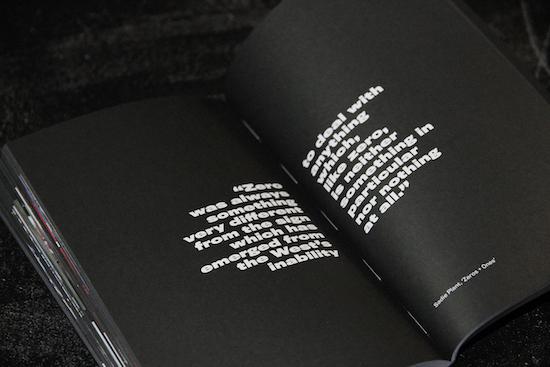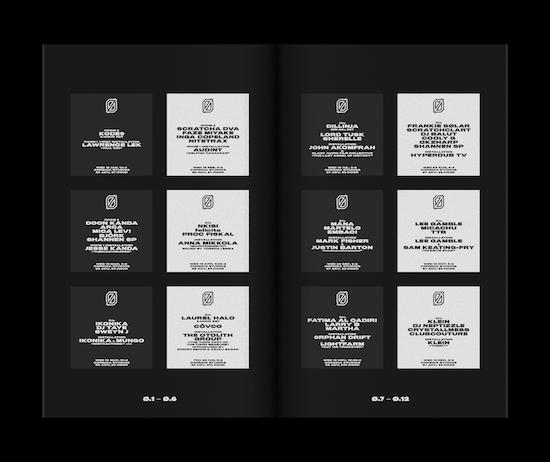From 2017 to 2020, Shannen SP and Kode 9 fused club culture and multidisciplinary art through a series of monthly nights, entitled Ø, at Corsica Studios, Elephant and Castle. The series is documented in a newly released book on Hyperdub’s new publishing imprint, Flatline Press, which includes photography, conceptual abstracts, and Optigram’s flyer archive.
With hybrid lineups you would be hard pushed to find elsewhere in Britain – aside from The White Hotel in Salford or Sheffield’s No Bounds Festival – the unmissable nights aimed to showcase both the UK’s thriving underground scene, as well non-eurocentric, disaporic sounds emanating from Africa, Asia, and the Americas. They reflected the diverse, genre-bending output of Hyperdub, which has ranged from DJ Rashad’s pioneering footwork classic Double Cup to the Diggin’ in the Carts compilation which showcased rare Japanese video game music.
During the Ø events, Corsica’s Room 1 was typically transformed from a club into an installation space, where themes of hauntology and alternative futures were explored through myriad forms of new media: From The Black Audio Film Collective’s Afrofuturist sci-fi film, The Last Angel of History, to Mark Fisher and Justin Barton’s audio essay ‘londonunderlondon’, a haunting alternative history of the capital.
While Room 2’s powerful sound system was tested by Dillinja’s unrelenting 90s jungle, Batu’s percussive Timedance rhythms and DJ Lag’s bassy Gqom beats. Just through the doors of Room 2, the book’s afterword talks of Corsica’s long and thin smoking area with views of South East London, where the sharing of thoughts and ideas occurred amidst the passing around of a strong weed vape.
What compelled you to document this series of events in a book?
Shannen SP: We wanted to create a time capsule for the event series, everyone went through it in the pandemic. Ø and the world it existed in felt alien almost. It was a celebration of simpler times and an amazing project.
Kode 9: I’d been thinking about a few Hyperdub book related projects for a while, but at the beginning of 2021, Manny, who did all the design for the logo, flyers, website for the night, came up with the idea, as we pretty much had all the material already. Previously, I’d had a real soft spot for the pocket sized books that had come on Semiotexte in the 80s featuring the likes of [Jean} Baudrillard and [Paul] Virilio so I wanted to follow that size instead of doing an oversized art catalog type thing. It also was the perfect way to start our publishing imprint Flatlines.

What is the significance of the title?
Kode 9: That the night was called Ø was really just a continuation of the concept from my last album Nothing in 2015, and the ‘Notel’ project which grew out of that in collaboration with Lawrence Lek. I was interested in the number zero, the tension in having a symbol that marks a defined place on the number line or that amplifies numbers by appending it, but simultaneously stands for the undefined infinity of nothing, simultaneously a void, a reset, a starting point, a middle and an end. With the night, instead of an uninhabited void, this Ø would be a plenum which is an idea I liked from Sadie Plant’s Zeros & Ones which is quoted in the book.
Could you give some backstory on why you decided to start staging these midweek nights at Corsica?
Shannen SP: We wanted to create a space where installations and audio-visual pieces could be experienced outside of the gallery context, with great sound systems. It also offered a different context for the audiences to engage with the music line ups we were booking. We wanted to intensify the audience’s experience of both the music and the installation segments, and experiment with the concept of, and challenge the idea of what ‘clubbing’ could be. There was a time we had a rave in room 2 with a Q & A with the Otolith group following their film The Third Part of the Third Measure in room 1.
Kode 9: We started mid-week to get a more dedicated, patient audience that were open to have their experience of clubbing broadened, not just get off their face – although that was also very welcome. Also, due to traveling for gigs, I’m often not around on a Friday or Saturday night so it had to fit with that schedule.
What do you think London’s nightlife lacks? What was your thought process in curating a series of nights that sought to fill this void?
Shannen SP: I think London’s nightlife lacks infrastructural support, which is something the pandemic showed us for sure. London nightlife is unique, we have so much variation. If you wanted to, you could go to a jazz night, a grime show, and a rave in the forest all in one day, and each one could have high quality artists and DJs if you picked right. Some cities’ music scenes are so homogenous that it’s hard to cultivate scenes that deviate from one particular genre. People can be scared to take risks. We have something special, it’s not perfect by any means but events that cater marginalised audiences are doing great work and should be supported more.
Kode 9: For me, what was lacking was places to engage with films or installations outside of the often restrictive confines of conventional art institutions, or to go clubbing but have an option to do something apart from raving/smoking/drinking, etc. I wanted to bring together two ends of a spectrum, art and dance music, without attempting to water either down too much by fusing them (which is how I perceived a lot of so-called deconstructed club music from the last ten years). So to have a club room at full intensity and full vibration next door to an installation space without trying to force a synthesis between the two, or to relegate the non-music room to merely a ‘chill out’ room.’
Dating back to the 90s, I’ve been involved in a few art/music crossovers and collaborations so it was really just a continuation of that interest. The night also proved an opportunity to do an experiment of running a night with no headliners and each night performing and installation artists being paid the same, with profits being split equally between them.

How important is it to have nights, such as Ø, that serve as a safe space for all communities to freely express themselves in a city where this is not always the case?
Shannen SP: It’s not only important for audience members but also for artists. Doing such a DIY event meant that we could take risks, and rally build a community around Ø’s ethos. We were able to platform younger artists and musicians, show works in progress and offer an alternative for artists who are more experimental in their approach than a lot of mainstream and big money dance events. Ø didn’t demand perfect mixing from DJs or high budget works from the A/V artists, and that’s where the joy in it lay. It’s super important to have alternative events where people can freely express themselves and their ideas, and learn something new or else things become homogeneous.
Kode 9: London clubbing can be very cliquey so it was important to us that the night could work as a hub for many different communities or scenes or identities and not merely reinforce the niches people retreat into to feel safe. I’m certainly more interested in events that allow people to make alliances with people from different backgrounds. I hope this is reflected in the range of artists we booked for the night and the artists we work with at Hyperdub as well.
Could you talk a bit about a specific night that you found particularly powerful/memorable from the series and explain why?
Shannen SP: I was very moved by Venus Ex Machina’s performance, where she read out the GPS coordinates of stop and searches that led to no further action in a London Borough over the space of a month. It was upsetting to watch as she was reading out the coordinates for hours, and became disorientated by the end of the night, but she was determined to carry out the performance until the end of the night. Screening the Otolith Group’s work on the late Julius Eastman was also another special evening. Sharing The Last Angel of History with younger audiences who may not have seen it yet and aligning that with Dillinja closing out room 2 was special too. There were lots of special events. Special mention for Scraaatch’s set, Lechuga Zafiro, DJ Haram, Taye and Nazar. As well as the night where Jesse Kanda, Arca, Björk, and Mica Levi performed! There have been lots of powerful and memorable moments.
Kode 9 : There were so many memorable nights to be honest. But one of the key concepts behind the night was exploring non-western futurisms with the music and installations. So in this regard, Black Audio Film Collective’s The Last Angel of History (which was a big influence on the birth of Hyperdub and also my own book Sonic Warfare), Lawrence Lek’s Hua Wei (otherwise known as ‘Sinofuturism’), Ayeesha Hamid’s Black Atlantis and Amra’s Jodhpur Boom all explored aspects of Afro, Chinese, and Indian diasporic futurism. The night we hosted the Otolith Group installation was also special as after the screening there was spontaneous discussion with the artists and crowd.
Musically, playing all night every January were literally some of my own favourite gigs ever. It was such a joy to play on that sound system in Room 2. In particular, the first event, which was a few days after Mark Fisher died back in 2017 was particularly poignant and the emotions that night were super intense for a lot of people in attendance. Also having Dillinja, Lord Tusk, and Sherelle on the same line up captured a certain London musical lineage (from dub to jungle and beyond) very well across generations, and having our friends from the Shanghai-based label Svbcvlt do a showcase was epic after them generously hosting me there so many times. But honestly, there were so many special performances and installations, and I think everyone would have their own, different favourites. Really it was amazing to meet and host so many international musicians. But I suppose that’s why we wanted to do the book, as a kind of little memory capsule for everyone that attended over the three years.
Why Corsica Studios? And will there continue to be Ø nights at the venue?
Shannen SP: Corsica’s bone rattling sound system! That’s why. Also they paid a real attention to detail and supported us massively throughout the project. It’s hard to imagine working with a better venue. Also the location of Corsica (Elephant and Castle) felt the most accessible for people living in different areas of London to reach the night.
Kode 9: For me it was the perfect little spot for the concept of the night. Two similar size rooms that could put the installations and the music on a level with each other without either being the main event. The sound in each room is some of the best in London. Everyone that worked at Corsica Studios was so accommodating without restricting our use of darkness, smoke, etc. or the typically overbearing and often irrational health & safety I’ve encountered in art institutions. There may be more events in the future, but since the pandemic I’m too busy making and finishing work.


